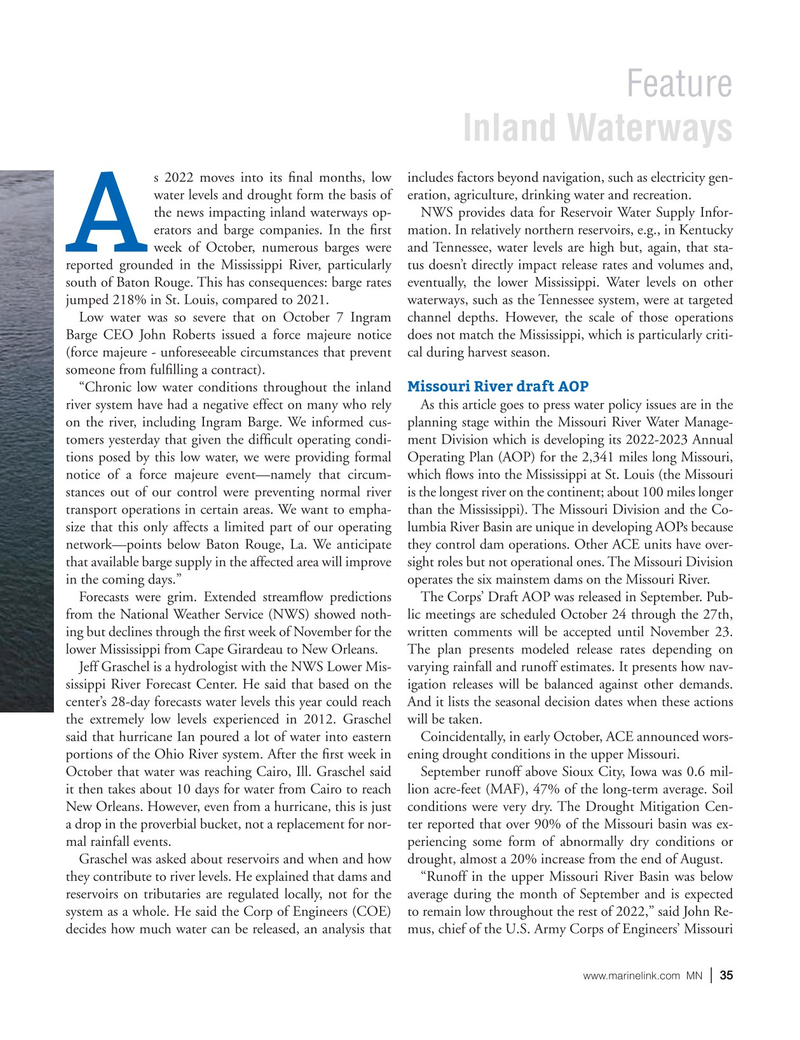
Page 35: of Marine News Magazine (November 2022)
Great Workboats of 2022
Read this page in Pdf, Flash or Html5 edition of November 2022 Marine News Magazine
Feature
Inland Waterways s 2022 moves into its ? nal months, low includes factors beyond navigation, such as electricity gen- water levels and drought form the basis of eration, agriculture, drinking water and recreation.
the news impacting inland waterways op- NWS provides data for Reservoir Water Supply Infor- erators and barge companies. In the ? rst mation. In relatively northern reservoirs, e.g., in Kentucky
A week of October, numerous barges were and Tennessee, water levels are high but, again, that sta- reported grounded in the Mississippi River, particularly tus doesn’t directly impact release rates and volumes and, south of Baton Rouge. This has consequences: barge rates eventually, the lower Mississippi. Water levels on other jumped 218% in St. Louis, compared to 2021. waterways, such as the Tennessee system, were at targeted
Low water was so severe that on October 7 Ingram channel depths. However, the scale of those operations
Barge CEO John Roberts issued a force majeure notice does not match the Mississippi, which is particularly criti- (force majeure - unforeseeable circumstances that prevent cal during harvest season.
someone from ful? lling a contract).
“Chronic low water conditions throughout the inland Missouri River draft AOP river system have had a negative effect on many who rely As this article goes to press water policy issues are in the on the river, including Ingram Barge. We informed cus- planning stage within the Missouri River Water Manage- tomers yesterday that given the dif? cult operating condi- ment Division which is developing its 2022-2023 Annual tions posed by this low water, we were providing formal Operating Plan (AOP) for the 2,341 miles long Missouri, notice of a force majeure event—namely that circum- which ? ows into the Mississippi at St. Louis (the Missouri stances out of our control were preventing normal river is the longest river on the continent; about 100 miles longer transport operations in certain areas. We want to empha- than the Mississippi). The Missouri Division and the Co- size that this only affects a limited part of our operating lumbia River Basin are unique in developing AOPs because network—points below Baton Rouge, La. We anticipate they control dam operations. Other ACE units have over- that available barge supply in the affected area will improve sight roles but not operational ones. The Missouri Division in the coming days.” operates the six mainstem dams on the Missouri River.
Forecasts were grim. Extended stream? ow predictions The Corps’ Draft AOP was released in September. Pub- from the National Weather Service (NWS) showed noth- lic meetings are scheduled October 24 through the 27th, ing but declines through the ? rst week of November for the written comments will be accepted until November 23. lower Mississippi from Cape Girardeau to New Orleans. The plan presents modeled release rates depending on
Jeff Graschel is a hydrologist with the NWS Lower Mis- varying rainfall and runoff estimates. It presents how nav- sissippi River Forecast Center. He said that based on the igation releases will be balanced against other demands. center’s 28-day forecasts water levels this year could reach And it lists the seasonal decision dates when these actions the extremely low levels experienced in 2012. Graschel will be taken. said that hurricane Ian poured a lot of water into eastern Coincidentally, in early October, ACE announced wors- portions of the Ohio River system. After the ? rst week in ening drought conditions in the upper Missouri.
October that water was reaching Cairo, Ill. Graschel said September runoff above Sioux City, Iowa was 0.6 mil- it then takes about 10 days for water from Cairo to reach lion acre-feet (MAF), 47% of the long-term average. Soil
New Orleans. However, even from a hurricane, this is just conditions were very dry. The Drought Mitigation Cen- a drop in the proverbial bucket, not a replacement for nor- ter reported that over 90% of the Missouri basin was ex- mal rainfall events. periencing some form of abnormally dry conditions or
Graschel was asked about reservoirs and when and how drought, almost a 20% increase from the end of August.
they contribute to river levels. He explained that dams and “Runoff in the upper Missouri River Basin was below reservoirs on tributaries are regulated locally, not for the average during the month of September and is expected system as a whole. He said the Corp of Engineers (COE) to remain low throughout the rest of 2022,” said John Re- decides how much water can be released, an analysis that mus, chief of the U.S. Army Corps of Engineers’ Missouri www.marinelink.com MN 35|

 34
34

 36
36
